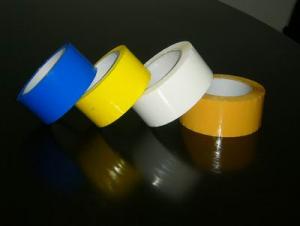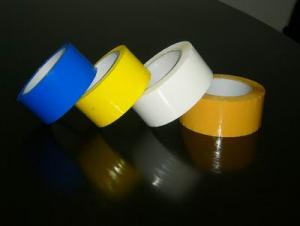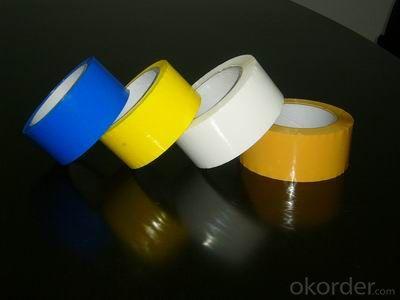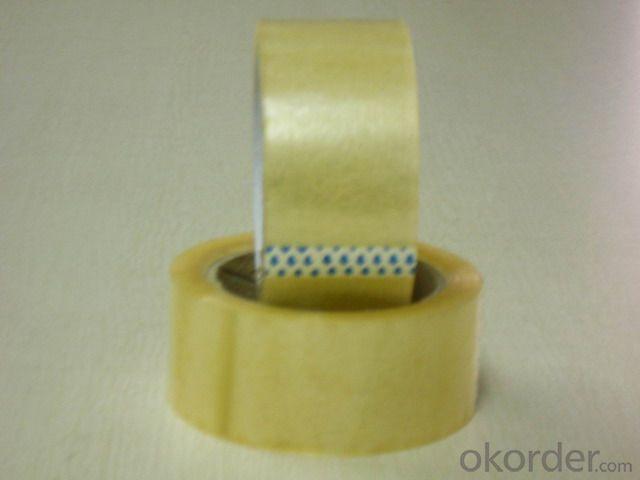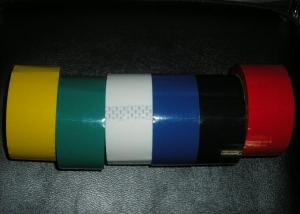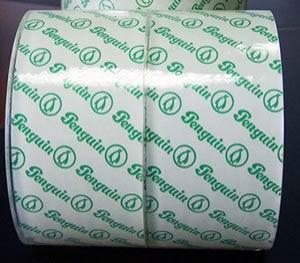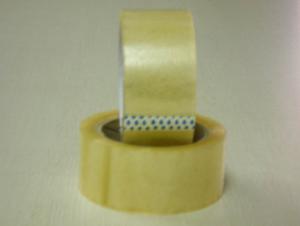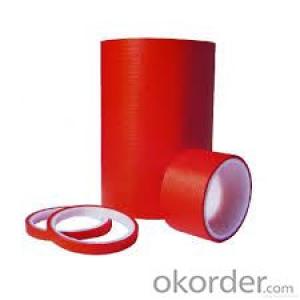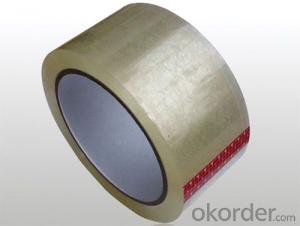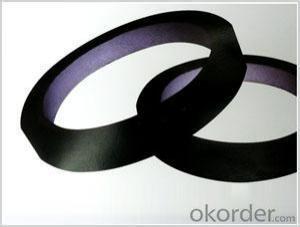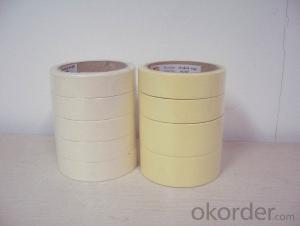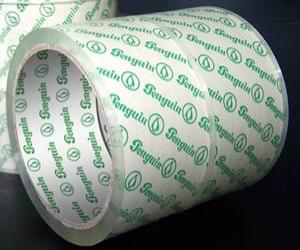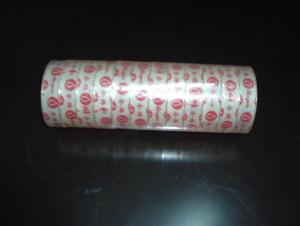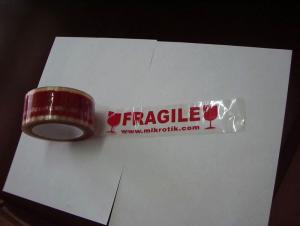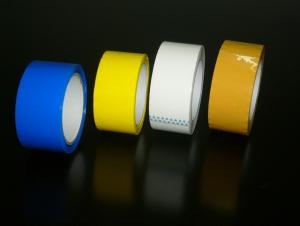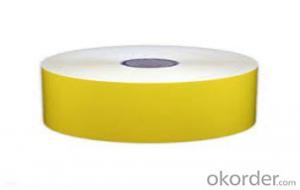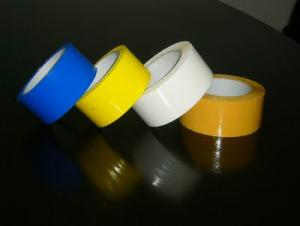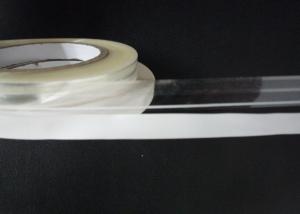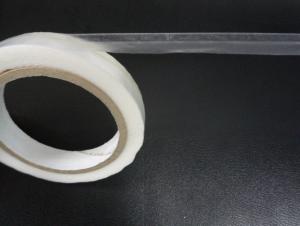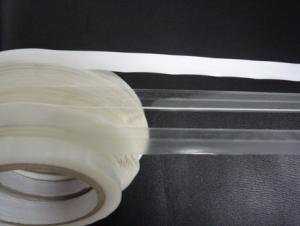Packaging Tape Strip Printed BOPP Tape
- Loading Port:
- Shenzhen
- Payment Terms:
- TT
- Min Order Qty:
- 3000USD roll
- Supply Capability:
- 1x 20 ft roll/month
OKorder Service Pledge
OKorder Financial Service
You Might Also Like
Quick details:
Material: BOPP
Use: Carton Sealing
Adhesive Side: Single Sided
Adhesive: Acrylic
Adhesive Type: Water Activated
Design Printing: Offer Printing
Place of Origin: China (Mainland)
color: clear, super clear, crystal clear, red, blue, brown, yellow, green etc
Specifications:
| ItemNo. | Carrier | Adhesive | Total Thickness | Initial Tack | Peel Adhesion | Holding Power | Tensile Strength | Elongation |
| BP-40 | BOPP film | water based acrylic | 40 micron | >18# | 0.5kgf/25mm | >24h | >30N/cm | <180% |
| BP-45 | BOPP film | water based acrylic | 45 micron | >18# | 0.5kgf/25mm | >24h | >30N/cm | <180% |
| BP-50 | BOPP film | water based acrylic | 50 micron | >20# | 0.5kgf/25mm | >24h | >30N/cm | <180% |
| BP-65 | BOPP film | water based acrylic | 65 micron | >24# | 7.88N/25mm | >40h | >30N/cm | <180% |
Application:
Bopp tape is mainly for Carton sealing & packing, Light duty packaging, bundling, holding, and other office & household use.
Packing:
Paper Core ID: 76mm
Jumbo size: 1280mm x 4000m; 1620mm x 4000m
Cut roll size: As per customer's requirement
Cut rolls: 6 rolls per shrink, 36/54/72 rolls per carton with or without pallet
Jumbo rolls & log rolls: Packed with kraft paper and stretch wrap film, with or without pallet
Company Advantages:
1. Stable financial status and sound reputation as a state invested corporation under the direct administration of the State Council of PRC;
2. CNBM’s world wide influence as one of the 500 global fortunes specializing in building materials including adhesive tapes;
3. More than a decade’s exporting experience and technology in adhesive tape industry;
4. Preferencial shipping channels, with a separate team dealing with shipping.
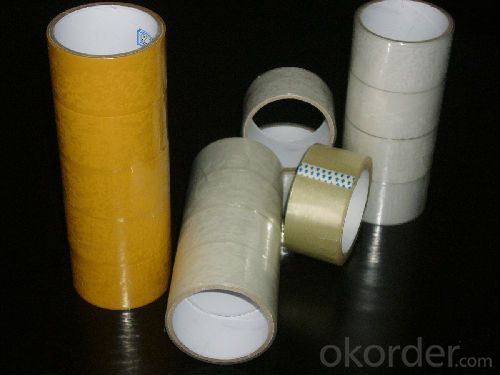
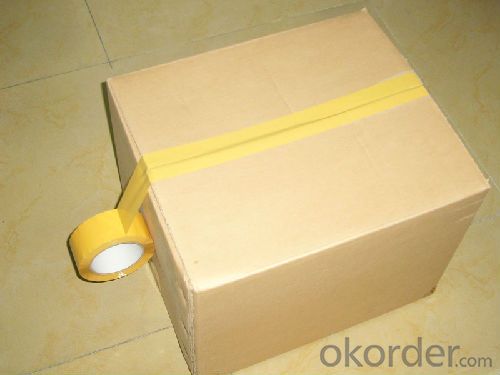

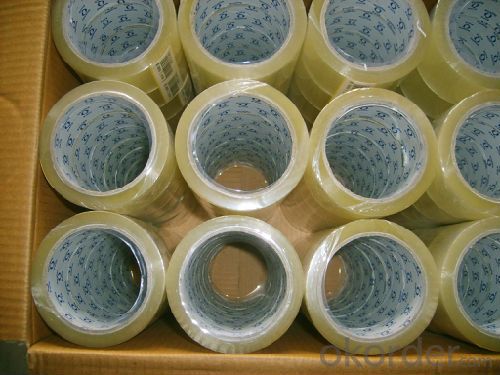

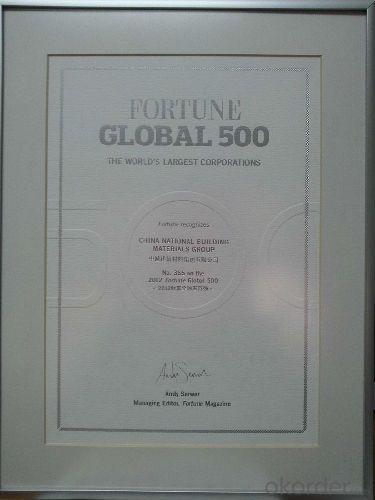
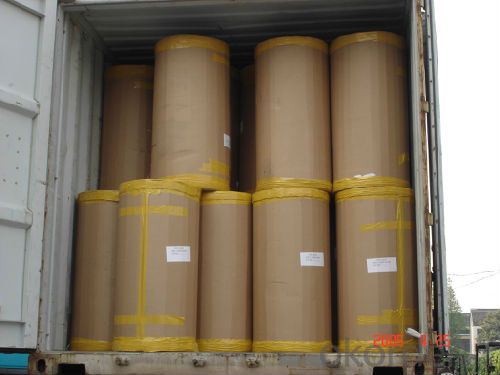
- Q: What is the difference between acrylic and hot melt adhesive for packaging tape?
- Packaging tape commonly utilizes two types of adhesives: acrylic and hot melt. These adhesives possess distinct characteristics that set them apart. A significant disparity lies in their bonding strength. Hot melt adhesive boasts exceptional bonding strength, making it ideal for heavy-duty applications. It creates a robust and durable bond that can withstand rigorous handling and varying temperatures. Conversely, acrylic adhesive typically offers a lower level of bonding strength in comparison. While still suitable for most general packaging requirements, it may not be the best choice for heavy or bulky items. Another distinction can be found in the application process. Hot melt adhesive is applied in a molten state and solidifies once cooled. Typically, it is dispensed using a hot melt glue gun or applicator. The quick setting time of hot melt adhesive allows for swift packaging operations, making it popular in high-volume settings. On the other hand, acrylic adhesive is applied in a liquid form and requires some time to cure and establish a strong bond. It can be applied using a hand dispenser or tape gun, and optimal adhesion often necessitates some pressure. Moreover, hot melt adhesive demonstrates excellent adhesion to a wide array of surfaces, including cardboard, plastics, and metals. Its versatility allows for usage with various packaging materials. While acrylic adhesive also adheres well to different surfaces, it may not exhibit the same level of compatibility with certain low-energy surfaces, such as polyethylene or polypropylene. Furthermore, temperature resistance is an essential factor to consider. Hot melt adhesive performs admirably in both high and low temperatures, maintaining its bonding strength. It can endure freezing temperatures and heat without compromising its adhesive properties. Acrylic adhesive, while generally offering good temperature resistance, may not be as effective in extreme conditions, particularly at very high or low temperatures. In conclusion, the primary disparities between acrylic and hot melt adhesives for packaging tape lie in bonding strength, the application process, surface compatibility, and temperature resistance. While hot melt adhesive provides superior bonding strength, rapid setting time, and excellent temperature resistance, acrylic adhesive offers versatility, ease of application, and good adhesion to most surfaces. The choice between the two depends on specific packaging needs, materials used, and environmental conditions.
- Q: Can packaging tape be used for sealing cloth or fabric items?
- Yes, packaging tape can be used for sealing cloth or fabric items. Packaging tape is designed to be strong and adhesive, making it effective for securing and sealing various materials, including cloth and fabric. It can be particularly useful for sealing packages containing cloth or fabric items, providing a secure closure to prevent the contents from falling out or getting damaged during transportation or storage. Additionally, packaging tape is often transparent, allowing for easy identification of the contents without compromising the overall appearance of the cloth or fabric item.
- Q: Can packaging tape be used for sealing packages with heavy items?
- Yes, packaging tape can be used for sealing packages with heavy items. However, it is important to ensure that the tape is strong and durable enough to withstand the weight and provide proper sealing. It is recommended to use heavy-duty packaging tape specifically designed for sealing heavy packages to ensure secure packaging.
- Q: Is packaging tape safe to use on photographs?
- Packaging tape can be safely used on photographs when applied correctly and handled with care. Nevertheless, it is not advisable to use packaging tape on valuable or irreplaceable photographs. This is due to the potential risks of leaving residue or adhesive marks on the photos, which could lead to damage or deterioration of the image over time. It is recommended to opt for archival-quality materials that are specifically designed for preserving photographs, like acid-free photo corners or photo-safe adhesive. These alternatives guarantee the long-term safety and preservation of the photographs without causing any harm.
- Q: Can packaging tape be used for sealing plastic or poly bags?
- Yes, packaging tape can be used for sealing plastic or poly bags. It provides a strong and reliable seal that helps keep the contents of the bag secure and protected.
- Q: Can packaging tape be used for sealing packages with irregular shapes?
- Indeed, when it comes to sealing packages with irregular shapes, packaging tape comes in handy. Its flexibility and adhesive nature make it perfect for securing packages of different sizes and contours. Thanks to its strong adhesive properties, packaging tape can adhere to various surfaces, even those that are uneven or irregular, ensuring that the package remains tightly sealed during transportation. Moreover, packaging tape is known for its durability and tear-resistance, providing an added layer of protection for the package. Consequently, whether the package boasts an irregular shape or not, packaging tape proves to be a dependable and efficient choice for sealing it securely.
- Q: Does packaging tape come in different textures?
- No, packaging tape typically does not come in different textures. It is commonly made of a smooth and adhesive material for sealing packages securely.
- Q: Are there any safety precautions to consider when using packaging tape?
- Yes, there are a few safety precautions to consider when using packaging tape. First, always use caution when handling the tape dispenser to avoid accidental cuts or injuries. Ensure that the area where you are using the tape is clear of any obstacles or potential tripping hazards. It is also important to store the tape in a safe place, away from heat sources or direct sunlight, as excessive heat can cause the tape to lose its adhesive properties. Lastly, be mindful of the weight and size of the package you are sealing, as using insufficient tape can cause the package to come apart during transportation.
- Q: Which kind of sealing tape is solvent resistant?
- Insulation properties are greatly improved with specifications (0.05mm-0.08mm) * various widths and lengths. The aluminum foil tape matches the joint of all the aluminum foil composite materials, the sealing of the puncture point of the heat preservation nail and the repair of the damaged part
- Q: Can packaging tape be used on different surfaces, such as cardboard, plastic, or metal?
- Yes, packaging tape can be used on different surfaces such as cardboard, plastic, or metal. Packaging tape is designed to provide a strong and secure seal, making it suitable for various materials. It adheres well to the rough surface of cardboard, ensuring that boxes and packages remain securely sealed during transit. Additionally, packaging tape can adhere to smooth surfaces like plastic, ensuring that items are securely packaged and protected. It can also be used on metal surfaces, providing a reliable seal for packages and boxes made of metal. Overall, packaging tape is versatile and can be used on different surfaces, making it an essential tool for packaging and shipping needs.
1. Manufacturer Overview
| Location | Fujian, China |
| Year Established | 1994 |
| Annual Output Value | Above US$ 1000 Million |
| Main Markets | Southeast Asia; South America; Eastern Europe; North America; Northern Europe; South Asia; Western Europe; Africa; Mid East |
| Company Certifications |
2. Manufacturer Certificates
| a) Certification Name | |
| Range | |
| Reference | |
| Validity Period |
3. Manufacturer Capability
| a) Trade Capacity | |
| Nearest Port | Shenzhen |
| Export Percentage | 41% - 50% |
| No.of Employees in Trade Department | 101-200 People |
| Language Spoken: | English; Chinese |
| b) Factory Information | |
| Factory Size: | Above 10,000 square meters |
| No. of Production Lines | Above 10 |
| Contract Manufacturing | produce single sided tapes,double sided tapes, masking tape, Opp tape |
| Product Price Range | Low; Average |
Send your message to us
Packaging Tape Strip Printed BOPP Tape
- Loading Port:
- Shenzhen
- Payment Terms:
- TT
- Min Order Qty:
- 3000USD roll
- Supply Capability:
- 1x 20 ft roll/month
OKorder Service Pledge
OKorder Financial Service
Similar products
Hot products
Hot Searches
Related keywords
